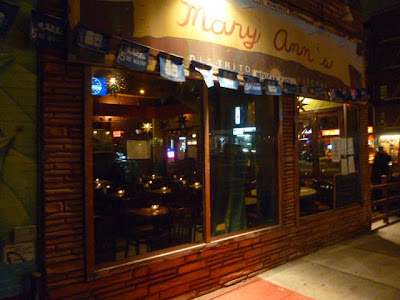
As Goggla sent along tonight: "I thought they were finally closed?! Despite 'closed' and 'for rent' signs, Supderdive appears to be open."
An investigative team will be dispatched, if he feels like getting off the couch.
















$780 Female Roommate Wanted - Your own bedroom in 2 1/2 Bedroom apartment (East Village)
Date: 2010-11-16, 8:44PM EST
Furnished bedroom available in spacious 2 1/2 bedroom apartment. Doorman, high floor, city and sunset views, sunny, etc. Washer, dryer and dishwasher in the apartment. The apartment has good heat, is quiet for sleeping, has good air-conditioning, high speed internet and a spare computer for the roommate's use. It's an elevator building and there is a health club in the building. The room is about 200 sq. ft., has a double bed, dresser, desk, walk in closet and a window with a nice view. I'm looking for a female roommate who will occasionally not wear clothes when I ask in exchange for free rent. No sex whatsoever required. Otherwise the rent is $780/month, everything included.








These houses were the first and only structures ever built on these sites and retain a remarkable level of original architectural detail. Having evolved from shipbuilding merchant’s homes to multi-family tenements to a synagogue to the home of an anarchist utopian arts collective, 326 & 328 East 4th Street capture New York and especially the East Village’s evolution over more than a century and a half. With all-too-few buildings in the East Village enjoying much-needed landmark protections, we must save 326 & 328 East 4th Street before it is too late!







The Hamilton-Holly House is an 1831 landmarked, Federalist style building which has housed the clothing store Trash And Vaudeville since 1971 (and has sold spandex to famous and not so famous rock and rollers ever since.)
This building is most notably characterized by its unusual 26-foot width and 3-1/2-story height, long parlor floor windows, unique vermiculated, rounded entranceway, molded pediment lintels, peaked roof, and double segmental dormers.
The high-stoop and peaked roof also makes this a unique Federal-era construct.
This house, along with the entire block, was developed by Thomas E. Davis, who sold 4 St. Marks place to US Secretary of Treasury, Alexander Hamilton's Son in 1833, and lived here with his widowed mom and their immediate families for nearly a decade. (Alexander Hamilton was killed in a pistol duel with Arron Burr a few years prior.)
The Van Wyck family owned 4 St. Marks in 1855 when a classified ad appeared in The New York Times reading, ''Respectable middle-aged Scotch or German Protestant woman wanted to do the general work of a small family; apply immediately at No. 4 St. Marks Place.''
By 1870, the neighborhood was much less fashionable, and a census record shows the building was used as a boarding or lodging house.
It has been widely rumored that Last of the Mohicans author, James Fenimore Cooper lived here in the 1830s, but little evidence shows this is the case. At least not during this time period. (There were already two families of Hamiltons and Hollys occupying the space, among other discrepancies and lack of evidence.)
In the 1950's and 60's, this building hosted a variety of cutting-edge performance art spaces which ended up challenging the limits of the First Amendment in Vietnam War-era America.
The Tempo Playhouse and the New Bowery Theater were two notables, but The Bridge Theater really “pushed the limits” of freedom of speech and was eventually shut down.
The Bridge Theater was a Fluxus art house, and hosted the likes of Yoko Ono, The Fugs, and the Bread and Puppet Theater. Fluxus art is based on the work and philosophy of artist Allan Kaprow; and is mainly comprised of group-based, improvised, interactive, mixed-media performance art.